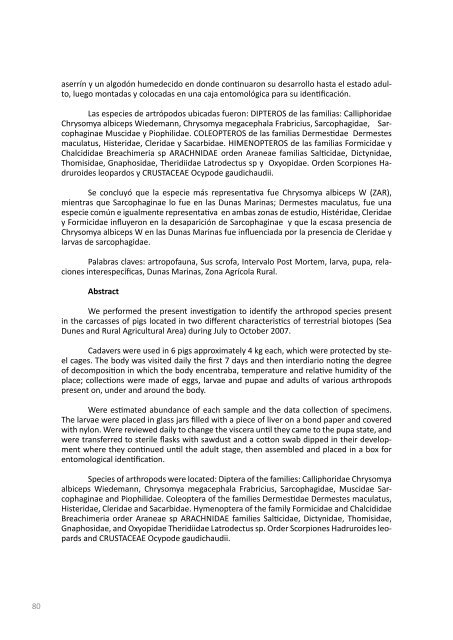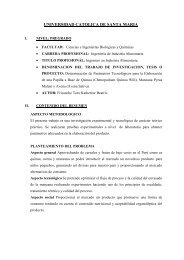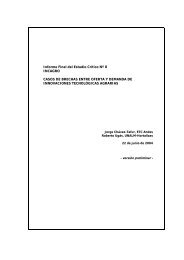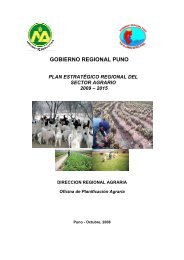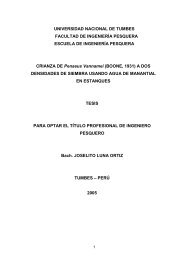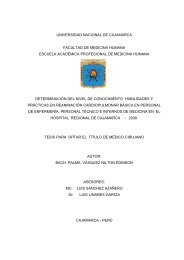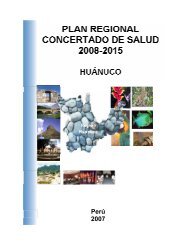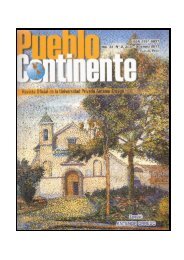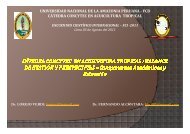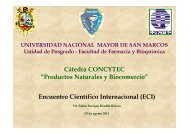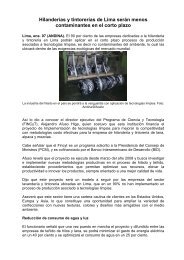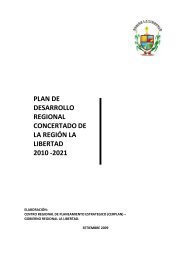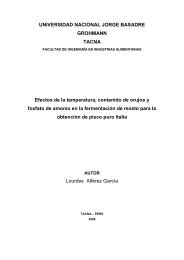REVISTA CIENTÍFICA - Consejo Nacional de Ciencia y Tecnología ...
REVISTA CIENTÍFICA - Consejo Nacional de Ciencia y Tecnología ...
REVISTA CIENTÍFICA - Consejo Nacional de Ciencia y Tecnología ...
You also want an ePaper? Increase the reach of your titles
YUMPU automatically turns print PDFs into web optimized ePapers that Google loves.
80<br />
aserrín y un algodón hume<strong>de</strong>cido en don<strong>de</strong> continuaron su <strong>de</strong>sarrollo hasta el estado adulto,<br />
luego montadas y colocadas en una caja entomológica para su i<strong>de</strong>ntificación.<br />
Las especies <strong>de</strong> artrópodos ubicadas fueron: DIPTEROS <strong>de</strong> las familias: Calliphoridae<br />
Chrysomya albiceps Wie<strong>de</strong>mann, Chrysomya megacephala Frabricius, Sarcophagidae, Sarcophaginae<br />
Muscidae y Piophilidae. COLEOPTEROS <strong>de</strong> las familias Dermestidae Dermestes<br />
maculatus, Histeridae, Cleridae y Sacarbidae. HIMENOPTEROS <strong>de</strong> las familias Formicidae y<br />
Chalcididae Breachimeria sp ARACHNIDAE or<strong>de</strong>n Araneae familias Salticidae, Dictynidae,<br />
Thomisidae, Gnaphosidae, Theridiidae Latro<strong>de</strong>ctus sp y Oxyopidae. Or<strong>de</strong>n Scorpiones Hadruroi<strong>de</strong>s<br />
leopardos y CRUSTACEAE Ocypo<strong>de</strong> gaudichaudii.<br />
Se concluyó que la especie más representativa fue Chrysomya albiceps W (ZAR),<br />
mientras que Sarcophaginae lo fue en las Dunas Marinas; Dermestes maculatus, fue una<br />
especie común e igualmente representativa en ambas zonas <strong>de</strong> estudio, Histéridae, Cleridae<br />
y Formicidae influyeron en la <strong>de</strong>saparición <strong>de</strong> Sarcophaginae y que la escasa presencia <strong>de</strong><br />
Chrysomya albiceps W en las Dunas Marinas fue influenciada por la presencia <strong>de</strong> Cleridae y<br />
larvas <strong>de</strong> sarcophagidae.<br />
Palabras claves: artropofauna, Sus scrofa, Intervalo Post Mortem, larva, pupa, relaciones<br />
interespecíficas, Dunas Marinas, Zona Agrícola Rural.<br />
Abstract<br />
We performed the present investigation to i<strong>de</strong>ntify the arthropod species present<br />
in the carcasses of pigs located in two different characteristics of terrestrial biotopes (Sea<br />
Dunes and Rural Agricultural Area) during July to October 2007.<br />
Cadavers were used in 6 pigs approximately 4 kg each, which were protected by steel<br />
cages. The body was visited daily the first 7 days and then interdiario noting the <strong>de</strong>gree<br />
of <strong>de</strong>composition in which the body encentraba, temperature and relative humidity of the<br />
place; collections were ma<strong>de</strong> of eggs, larvae and pupae and adults of various arthropods<br />
present on, un<strong>de</strong>r and around the body.<br />
Were estimated abundance of each sample and the data collection of specimens.<br />
The larvae were placed in glass jars filled with a piece of liver on a bond paper and covered<br />
with nylon. Were reviewed daily to change the viscera until they came to the pupa state, and<br />
were transferred to sterile flasks with sawdust and a cotton swab dipped in their <strong>de</strong>velopment<br />
where they continued until the adult stage, then assembled and placed in a box for<br />
entomological i<strong>de</strong>ntification.<br />
Species of arthropods were located: Diptera of the families: Calliphoridae Chrysomya<br />
albiceps Wie<strong>de</strong>mann, Chrysomya megacephala Frabricius, Sarcophagidae, Muscidae Sarcophaginae<br />
and Piophilidae. Coleoptera of the families Dermestidae Dermestes maculatus,<br />
Histeridae, Cleridae and Sacarbidae. Hymenoptera of the family Formicidae and Chalcididae<br />
Breachimeria or<strong>de</strong>r Araneae sp ARACHNIDAE families Salticidae, Dictynidae, Thomisidae,<br />
Gnaphosidae, and Oxyopidae Theridiidae Latro<strong>de</strong>ctus sp. Or<strong>de</strong>r Scorpiones Hadruroi<strong>de</strong>s leopards<br />
and CRUSTACEAE Ocypo<strong>de</strong> gaudichaudii.


